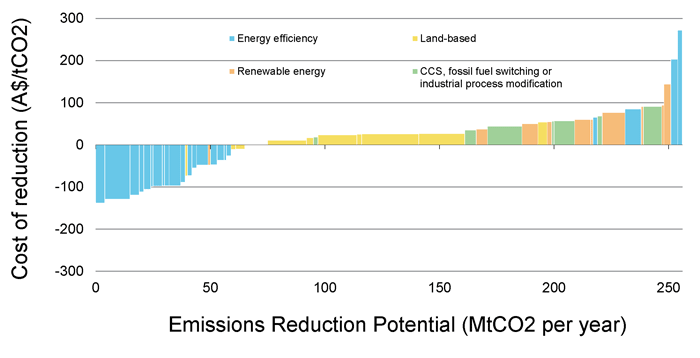Anita Talberg, Science, Technology, Environment and Resources, and Kai Swoboda, Economics
Key issue
There is no silver bullet for reducing Australia’s greenhouse gases. The challenge is determining the right combination of policy responses. Improving energy efficiency can be a useful path—it can reduce both emissions and operating costs at the same time. |
Australian emissions reduction cost curve
Although sometimes costly in the shorter term, improving the efficiency of energy use can provide economic benefits in the longer term. The marginal cost graph of emissions reductions, shown below, ranks the cost and abatement of policy options, classified into categories. Several energy efficiency developments are ranked highly (on the left). This means that making those changes can lead to considerable abatement for little long-term cost, or even for financial gain.
Australian emissions reduction cost curve

Source: Parliamentary Library using ClimateWorks data.
The potential of energy efficiency in Australia
According to research group ClimateWorks, improving the energy efficiency of commercial buildings and industrial processes and equipment could save 46.9 million tonnes of greenhouse gas emissions per year. If correct, this would represent nearly one-third of Australia’s current abatement challenge (of cutting 155 million tonnes of greenhouse gases in 2020). It could also save businesses $1.7 billion and another $2.3 billion across the economy per year.
|
Energy efficiency policies in Australia: current and proposed
Mechanisms targeting business and industry have proven successful. For example, the Energy Efficiency Opportunities Program, which requires large energy-using companies to submit reports on energy-saving opportunities within the business, has been running since 2006. Successive reviews of the program have concluded that it is effective.
Australia’s states have been frontrunners in energy efficiency policies. Both Victoria and New South Wales (NSW) operate market-based schemes that require energy retailers to relinquish tradeable energy efficiency certificates demonstrating that energy savings have taken place. Similar schemes (although without the use of certificates) operate in South Australia and the Australian Capital Territory.
Most jurisdictions have also implemented programs that help businesses identify energy efficiency opportunities. For example, Victoria is rolling out digital ‘smart meters’ that allow power companies to track energy usage in real time. The aim is to help electricity retailers better manage demand by offering customers flexible pricing structures. All states and territories operate schemes to regulate minimum energy performance standards (MEPS) and product labelling. Federal legislation was passed in 2012 to harmonise and expand the MEPS schemes nationally.
To accelerate progress in energy efficiency, in 2009 the Council of Australian Governments agreed on a National Strategy on Energy Efficiency (NSEE) for ‘a nationally consistent and coordinated approach to energy efficiency’. In the lead-up to the 2013 election, the Australian Greens released their own policy for reducing energy intensity and cutting electricity bills. The proposal details the creation of an Energy Savings Agency (ESA) charged with removing barriers and creating incentives for energy efficiency by providing ‘information, analysis, advocacy and financial support’. Amongst other responsibilities, the ESA would make recommendations on the implementation and design of a market-based scheme like those operating in Victoria and NSW.
The Coalition has been less explicit in its position on energy efficiency. From a policy perspective, it treats energy conservation as one of many ways to reduce greenhouse gas emissions, all of which will be eligible for funding from the Emissions Reduction Fund that forms part of its Direct Action Plan.
Impediments to energy efficiency
In a perfect world, rising energy prices and the imposition of a carbon price might be enough to stimulate improvements in energy efficiency. In reality there are a number of barriers that systematically stall such progress. Barriers relate to both the identification of, and investment in, energy efficiency opportunities.
One major hurdle for stakeholders is the lack of relevant information and data. Some, but not all, of the information gap can be remedied through government interventions, such as mandatory minimum standards and labelling.
Another important barrier is known as the split incentive. The most common example is that of the landlord versus the tenant. A landlord has no incentive to spend resources on improving energy efficiency if the tenant pays the energy bills and is therefore the one who will benefit from reduced energy costs. In the owner/tenant situation, government intervention can help address the issue to some extent through more stringent building standards.
Behaviour and cultural norms are also impediments to smarter energy use. Historically, Australian cities, housing and consumption patterns have not prioritised energy efficiency. It is often easier, more convenient and cheaper in the short term to disregard energy efficiency during decision-making. This is true even at the household level. There is, therefore, a large scope for improvement. Lack of change can be due to insufficient up-front funds, lack of motivation or awareness or the particular cultural norms of the people in question. Changing these factors is a challenge.
Further reading
National Energy Savings Initiative Working Group, Investigation of a National Energy Savings Initiative: economic modelling and potential regulatory impacts, Department of Resources, Energy and Tourism and Department of Industry, Canberra, July 2013.
Prime Minister’s Task Group on Energy Efficiency, Report of the Prime Minister’s Task Group on Energy Efficiency, Canberra, July 2010.
ClimateWorks, Low Carbon Growth Plan for Australia, March 2010.
For copyright reasons some linked items are only available to members of Parliament.
© Commonwealth of Australia